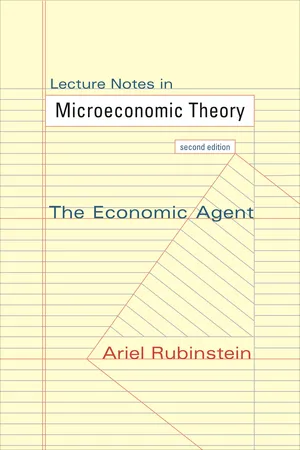
Lecture Notes in Microeconomic Theory
The Economic Agent - Second Edition
- 168 pages
- English
- ePUB (mobile friendly)
- Available on iOS & Android
About This Book
Ariel Rubinstein's well-known lecture notes on microeconomics—now fully revised and expanded This book presents Ariel Rubinstein's lecture notes for the first part of his well-known graduate course in microeconomics. Developed during the fifteen years that Rubinstein taught the course at Tel Aviv University, Princeton University, and New York University, these notes provide a critical assessment of models of rational economic agents, and are an invaluable supplement to any primary textbook in microeconomic theory.In this fully revised and expanded second edition, Rubinstein retains the striking originality and deep simplicity that characterize his famously engaging style of teaching. He presents these lecture notes with a precision that gets to the core of the material, and he places special emphasis on the interpretation of key concepts. Rubinstein brings this concise book thoroughly up to date, covering topics like modern choice theory and including dozens of original new problems.Written by one of the world's most respected and provocative economic theorists, this second edition of Lecture Notes in Microeconomic Theory is essential reading for students, teachers, and research economists.
- Fully revised, expanded, and updated
- Retains the engaging style and method of Rubinstein's well-known lectures
- Covers topics like modern choice theory
- Features numerous original new problems—including 21 new review problems
- Solutions manual (available only to teachers) can be found at: http://gametheory.tau.ac.il/microTheory/.
Frequently asked questions
Information
LECTURE 1
Preferences
Preferences
The Questionnaire Q










Table of contents
- Cover
- Half title
- Title
- Copyright
- Contents
- Preface
- Introduction
- Lecture 1. Preferences
- Lecture 2. Utility
- Lecture 3. Choice
- Lecture 4. Consumer Preferences
- Lecture 5. Demand: Consumer Choice
- Lecture 6. Choice over Budget Sets and the Dual Consumer
- Lecture 7. The Producer
- Lecture 8. Expected Utility
- Lecture 9. Risk Aversion
- Lecture 10. Social Choice
- Review Problems
- References
- Index